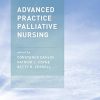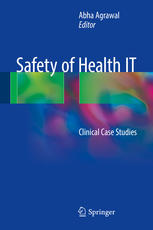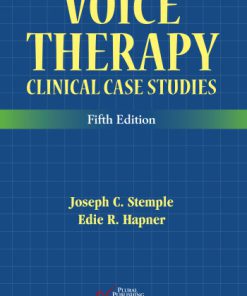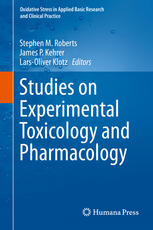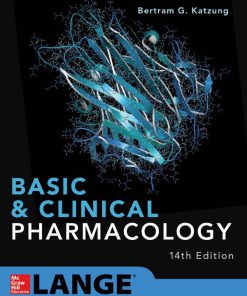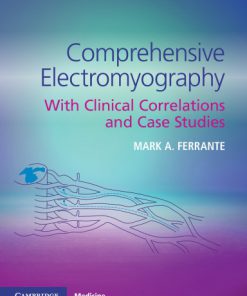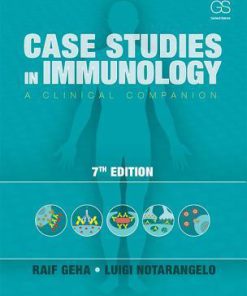Clinical Pharmacology Current Topics and Case Studies 2nd Edition by Markus Müller 3319273450 9783319273457
$50.00 Original price was: $50.00.$25.00Current price is: $25.00.
Clinical Pharmacology Current Topics and Case Studies 2nd Edition by Markus Müller – Ebook PDF Instant Download/Delivery:3319273450,9783319273457
Full download Clinical Pharmacology Current Topics and Case Studies 2nd Edition after payment
Product details:
ISBN 10:3319273450
ISBN 13: 9783319273457
Author:Markus Müller
This revised and extended second edition focuses on current and emerging topics in drug development, their molecular mechanisms of action as well as regulatory issues. In addition, in-depth insights into clinical drug research and trial methodology are presented on the basis of concrete case studies. This updated book makes a valuable contribution to the field of Clinical Pharmacology and serves as a must-have guide for professors, researchers and advanced students from academia and pharmaceutical industry.
Clinical Pharmacology Current Topics and Case Studies 2nd Table of contents:
Part I: Introduction
1: The Discipline of Clinical Pharmacology
References
2: Current Issues in Drug Development
2.1 Historical Success
2.2 The Dawn of the Molecular Era, the ‘Druggable Genome’ and the Market Fragmentation
2.3 Innovation and Stagnation
2.4 The Development of EBM Methodology
2.5 Issues in Preclinical and Clinical Drug Development
2.6 The Role of Academic Medicine
2.7 Confidence Crisis and Public Opinion
Conclusion
References
Further Reading
3: Current Issues in Drug Regulation
3.1 The Drug Regulators’ Decision-Making
3.2 Authorising a Medicinal Product in the EU
3.2.1 The Centralised Authorisation
3.2.2 The Mutual Recognition Procedure (MRP) and the Decentralised Procedure (DCP) [14]
3.2.3 The National Procedure
3.3 Regulatory Life Cycle Management of Medicinal Products
3.3.1 From Efficacy to Post-marketing Relative Effectiveness Assessment
3.3.2 Pharmacovigilance and Signal Detection
3.3.3 Risk Management Plans (RMPs)
3.3.4 When Should a Medicinal Product Be Authorised?
References
4: Current Topics in Drug Reimbursement
4.1 Introduction
4.2 Marketing Authorisation Versus Reimbursement
4.3 Relative Effectiveness and Health Technology Assessment in Europe: The Role of EUnetHTA
4.3.1 HTA: Definition
4.3.2 Relative Effectiveness Within the Context of HTA
4.3.3 Rapid Assessment
4.4 Austrian Case Study: Vive La Différence?
4.4.1 Interpretation
4.5 Thinking About Reimbursement During Drug Development
4.6 Tying It All Together: Electronic Health Records, Registries and Outcome-Based Pricing
4.6.1 Managed Entry Agreements
4.7 Summary and Conclusions
References
Part II: Clinical Trials
5: Ethics in Clinical Research
5.1 Development of Worldwide Standards in Clinical Research Ethics
5.2 Research Ethics Committees Today: Function and Composition
5.3 Research Ethics Committees: Issues of Debate
5.3.1 Increasing Workload
5.4 Compensation for Committee Members
References
6: Good Clinical Practice (GCP) and Scientific Misconduct
6.1 Good Clinical Practice
6.1.1 Historic Background
6.1.1.1 The Prussian Directive and the Case of Neisser
The Neisser Case
6.1.1.2 Federal Food and Drugs Act of 1906
6.1.1.3 The Sulphanilamide Disaster and the ‘Food, Drug and Cosmetic Act’, 1938
6.1.1.4 Second World War Crimes
Unit 731
Nazi Experiments
6.1.1.5 Nuremberg Trial and Nuremberg Code
6.1.1.6 Thalidomide (Contergan) Tragedy
6.1.1.7 Declaration of Helsinki [8]
6.1.2 Development of Good Clinical Practice Guidelines
6.1.2.1 International Conference of Harmonisation (ICH [16])
ICH Parties
ICH Observers
ICH Steering Committee
6.1.3 ICH Topics [17]
6.1.3.1 ICH TOPIC E6, Note of Guidance for Good Clinical Practice (CPMP/ICH/135/95): The Princip
6.1.3.2 Institutional Review Board/Independent Ethics Committee (IRB/IEC)
6.1.3.3 Investigator
Investigator’s Qualifications and Agreements
Should Study Participants Receive Payment?
Should There Be a Different Standard for Paying Healthy Subjects as Opposed to Patient Subjects
Patient Information
The Informed Consent Process
Records and Reports
Source Data
Case Record Form (CRF)
Archiving
Progress Reports
Safety Reporting
Serious Adverse Event
Suspected Unexpected Serious Adverse Event (SUSAR)
Causality Assessment
Final Reports
6.1.3.4 Sponsor
Quality Assurance and Quality Control
Additional Responsibilities of the Sponsor
6.1.4 Discussion
6.1.4.1 Is ICH–GCP Just a ‘Bronze Standard’? [20]
6.1.4.2 The E6(R2) Integrated Addendum [34]
6.1.4.3 ICH–GCP and Academic Research
6.1.5 Summary
6.2 Research Misconduct
6.2.1 What Is Research Misconduct?
6.2.2 Forms of Research Misconduct
6.2.3 How Common Is Research Misconduct or Fraud?
6.2.4 Conclusion
References
7: Phase I Studies and First-In-Human Trials
7.1 Introduction
7.2 Definition Phase I
7.3 General Considerations for Phase I Studies, Trial Design and Study Protocol
7.4 Preclinical Development
7.5 Choice of Subjects, Study Population
7.6 Dose Finding
7.7 Route and Rate of Administration
7.8 Clinical Environment
7.9 Specificities of First-in-Man Trials with Monoclonal Antibodies
References
Further Reading
8: Clinical Trials: Interventional Studies
8.1 Introduction
8.2 Types of Clinical Trials
8.2.1 Purpose
8.2.2 Definition
8.3 Randomization
8.3.1 The Basic Idea, Like Most Good Things Is Very Simple [2]
8.3.2 Simple Randomization
8.3.3 Permuted Block Randomization
8.3.4 Stratified Randomization
8.3.5 Pseudo-randomization
8.3.6 Allocation Concealment
8.4 Blinding
8.4.1 Human Behavior Is Influenced by What We Know or Believe
8.5 Different Study Designs
8.5.1 Parallel Group Design
8.5.2 Crossover Design
8.5.3 Factorial Design
8.6 Study Endpoint
8.7 Interim Analyses
References
9: Observational Studies
9.1 Introduction
9.2 Methodological Principles
9.2.1 Study Population
9.2.2 Data Sources
9.2.2.1 Exposure
9.2.2.2 Outcome
9.2.3 Measurement Issues
9.2.4 Measures of Association and Impact
9.2.5 Interpreting an Effect: Bias, Confounding, and Sampling Error
9.2.5.1 Bias
9.2.5.2 Confounding
9.2.5.3 Sampling Variation
9.3 Overview of Study Design Types
9.3.1 Descriptive Studies
9.3.2 Analytical Study Designs
9.3.2.1 Cross-Sectional Study
9.3.2.2 Cohort Study: Principles and Practical Example
9.3.2.3 Case-Control Study: Principles and a Practical Example
The Cases
The Controls and the Source Population
Measurement of the Main Exposure Factor
Handling Potential Confounders
Analysis and Results
Summary of Case-Control Studies
9.3.2.4 Case-Crossover Studies
9.3.3 Meta-analysis of Observational Studies
References
Further Reading
Part III: Tools in Clinical Pharmacology
10: Tools in Clinical Pharmacology: Imaging Techniques
10.1 Introduction
10.2 Positron Emission Tomography (PET)
10.3 Single-Photon Emission Computed Tomography (SPECT)
10.4 Optical Imaging
10.5 Magnetic Resonance Imaging (MRI)
10.6 Computed Tomography (CT)
10.7 Ultrasound Imaging
10.8 Example for Using PET in Drug Development: Aprepitant
References
11: Pharmacokinetics II: 14C-Labelled Microdosing in Assessing Drug Pharmacokinetics at Phase 0
11.1 Origins of 14C-Labelled Tracers
11.2 Administration of 14C-Drugs to Humans
11.3 Accelerator Mass Spectrometry
11.3.1 The Emergence of Microdosing
11.3.2 Application of Microdosing
11.4 Pharmacokinetic Linearity
11.5 Microdosing and Metabolism
Conclusions
References
12: Current Concepts of Pharmacogenetics, Pharmacogenomics, and the “Druggable” Genome
12.1 Genetic Variation in the Human Genome: Biological Basis of Pharmacogenetics
12.2 The Promise of Pharmacogenetics, Pharmacogenomics, and Genomic Medicine
12.3 Genetic Variants Affecting Pharmacokinetics
12.4 Pharmacogenetic Testing for Optimizing Drug Dose
12.5 Pharmacogenetic Testing to Prevent Adverse Drug Reactions
12.6 Genetics of Pharmacodynamics
12.7 The Predictive Power of Pharmacogenomics
12.8 The “Druggable” Genome
12.9 Challenges that Lie Ahead
References
13: Pharmacokinetics I: PK-PD Approach, the Case of Antibiotic Drug Development
13.1 Pharmacokinetics and Pharmacodynamics Concepts in Antimicrobials
13.1.1 Principles in Antimicrobial Pharmacokinetic and Pharmacodynamic
13.1.2 Free Unbound Drug Concentrations
13.1.3 Model-Based Drug Development
13.2 Designing Antimicrobial Experiments
13.2.1 Microdialysis for Determination of Time-Course of Free Drug Concentrations
13.2.2 Defining In Vitro Antimicrobial Action
13.2.3 In Vitro Time-Kill Kinetic Models
13.2.4 Animal Infection Models
13.3 Special Populations
13.3.1 Critically Ill Patients
13.3.2 Renal Impairment
13.3.3 Obesity
13.3.4 Geriatric Populations
13.3.5 Pediatric Populations
Conclusion
References
14: Epidemiology and Biostatistics
14.1 Introduction
14.2 Measures of the Disease Frequency
14.2.1 Prevalence
14.2.2 Incidence
14.2.3 Mortality
14.3 Relationship Between Prevalence, Incidence, and Mortality
14.4 Survival Analysis
14.5 Censured Data
14.6 Case Fatality Rate
14.7 Risk, Relative Risk, and Attributable Risk
14.8 Epidemiologic Study Designs
14.9 Statistical Measures
14.9.1 Why Use Statistics?
14.9.2 Variables
14.9.3 Presentation of Variables
14.10 Population and Sample
14.10.1 Hypothesis Testing and the p Value
14.10.2 Post Hoc Analysis or “Fishing for Results”
14.10.3 Multiple Testing
14.10.4 Correlation Analysis
14.10.5 Association and Causation
14.10.5.1 Association Strength
14.10.5.2 Temporal Relationship
14.10.5.3 Dose-Response Relationship
14.10.5.4 Constancy
14.10.5.5 Plausibility
14.10.5.6 Experiment
14.10.5.7 Specificity
References
15: Placebo Effects and Placebo Control in Clinical Trials
15.1 The Recent Debate About Research Ethics in Placebo-Controlled Trials (PCTs)
15.2 Placebo vs. Active Control
15.3 The Issue of “Assay Sensitivity”
15.4 Placebo-Controlled Trial: Ethical or Not?
15.4.1 The Concept of Non-inferiority to Placebo
15.5 Criteria for Justification of Placebo
References
Part IV: Topics in Clinical Pharmacology
16: Pharmaceutical Drug Safety
16.1 Introduction
16.2 Thalidomide: A Disaster as Starting Point for the Methodical Assessment of Drug Safety
16.3 During Drug Development Only Frequent ADRs Can Be Detected
16.4 ADR Reporting and Worldwide Pharmacovigilance
16.5 Spontaneous Reporting Systems
16.6 Drug Safety Issues After Lipobay and Vioxx
16.7 Recent and Future Developments in Pharmacovigilance
Conclusions
References
17: Drug Interactions
17.1 Definition
17.2 Relevance of Interactions
17.3 Categories of Interaction
17.4 Factors Promoting Interactions and Their Clinical Relevance
17.5 Most Important Mechanisms of Interactions According to the ADME Schemata
17.5.1 ADME: Interactions Based on Drug Absorption
17.6 ADME: Interactions Based on Drug Distribution
17.6.1 ADME: Interactions Based on Drug Metabolism
17.6.2 Examples for Clinically Relevant Interactions Based on CYP3A4
17.6.3 ADME: Interactions Based on Drug Excretion
17.7 Management of Potential Drug Interactions
References
18: Development of Advanced Therapy Medicinal Products: A Case for Early Scientific Advice
18.1 Introduction
18.2 Cell-Based Medicinal Products (CBMPs)
18.3 Efficacy and Safety Challenges
18.3.1 Patient Integration
18.3.2 Characterization
18.4 Gene Therapy Medicinal Products (GTMP)
18.5 Development Challenges and Strategies to Address Them
18.5.1 Vector Manufacture
18.5.2 Achieving Stable Gene Expression
18.5.3 Clinical Efficacy and Safety
18.6 Combined ATMPs
18.7 Involvement of CAT in ATMP Development
References
19: Biologics
19.1 Introduction
19.2 Specificity Versus Pleiotropy
19.3 Preclinical Development of Biologics
19.4 Specific Safety Consideration
19.5 Pharmacokinetic–Pharmacodynamic Properties
19.6 New Advances
References
20: Generics, Biosimilars, Enantiomers, and Me-Toos
20.1 Generics
20.1.1 Regulatory Background
20.1.2 Patent Protection, Data Protection, and Marketing Protection for New Products
20.1.3 Salts and Esters
20.1.4 Bioequivalence
20.1.5 Bioequivalence: Some Special Issues
20.1.5.1 Narrow Therapeutic Index Drugs (NTIDs)
20.1.5.2 Highly Variable Drug Products (HVDPs)
20.1.5.3 Chiral Drugs and Enantiomers
20.1.5.4 tmax
20.1.5.5 Drugs Which Are Not Orally Absorbed
20.1.5.6 Inhaled Drugs
20.1.5.7 Bioequivalence of Intravenous Products? Complex Parenterals
20.2 Biosimilars
20.2.1 Complexity
20.2.2 Biosimilars: General Issues
20.2.3 Regulatory Experience
20.3 Enantiomers
20.3.1 Sophisticated Nonsense?
20.3.2 Rationale for the Development of Chirally Pure Drugs
20.3.3 Pharmacodynamic and Kinetic Differences Between Enantiomers
20.3.4 Recent Regulatory Experience of the Chiral Switch: A Word of Caution
20.4 Me-Toos
20.4.1 Background
20.4.2 What Are “Me-Too” Drugs?
20.4.3 Is First-in-Class Also Best-in-Class?
20.4.4 What Is a Drug Class?
20.4.5 Is There a “Class Effect”?
References
21: Orphan Drugs for Rare Diseases
21.1 What Are Rare Diseases?
21.2 What Are Orphan Drugs?
21.3 The Orphan Drug Legislation
21.4 The Committee for Orphan Medicinal Products (COMP)
21.5 Orphan Incentives [1]
21.6 What Are the Criteria for Orphan Designation?
21.7 General Requirements for a Valid Condition for Orphan Designation [13]
21.8 What Data Are Necessary at the Time of Orphan Drug Designation?
21.8.1 Some Examples for a Positive Opinion for Orphan Designation
21.8.2 Reason for Negative Opinions: Subsetting, No Significant Benefit
21.8.2.1 Subsetting/Valid Condition
21.8.2.2 Significant Benefit
21.8.2.3 All Negative Opinions [21]
21.9 Scientific Advice: Protocol Assistance [22]
21.10 Confirmation of Orphan Status at the Time of Marketing Authorisation [24]
21.11 Challenging Marketing Exclusivity for Orphan Medicinal Products
21.12 Success of the Orphan Programme
21.12.1 Designated Orphan Medicinal Products
21.12.2 Marketing Authorisations for Orphan Medicinal Products
21.13 Discussion
21.14 Useful Links
References
22: Special Situations, Market Fragmentation II: Sex Differences
22.1 Expanding Scope of Gender and Sex Differences
22.2 Sex Versus Gender
22.3 Sex Matters
22.3.1 Physiological Variability
22.3.2 Pharmacokinetics: Sex Differences
22.3.3 Pharmacodynamic: Sex Differences
22.3.4 Female-Specific Aspects
22.3.5 Adverse Drug Reactions
22.3.6 Clinical Trials: Women’s Representation
22.3.6.1 History
22.3.6.2 Barriers of Participation in Clinical Trials
22.4 Regulatory Changes to Include Women in Clinical Trials
22.5 Pregnancy
22.6 From Sex Differences to Individual Differences: Where the Science Is Taking Us
References
23: Special Situations III: Medicines for Children
23.1 Children as Therapeutic Orphans
23.2 Hurdles to Drug Development for Children
23.2.1 Ethical and Legal Aspects
23.2.2 Lack of Public Acceptance
23.2.3 Methodological Challenges of Clinical Studies in Children
23.2.4 Lack of Research Infrastructures and Paediatric Research Networks
23.2.5 Low Economic Potential of Paediatric Indications for Pharmaceutical Industry
23.3 Regulatory Initiatives to Improve Paediatric Drug Development
23.3.1 Paediatric Initiatives in the USA
23.3.2 EU Paediatric Regulation
23.3.2.1 Requirements and Rewards
23.3.2.2 Paediatric Investigation Plan
23.3.2.3 Paediatric Committee
23.3.2.4 Collateral Measures
23.3.2.5 Achievements of the Paediatric Regulation
23.4 Points to Consider for a Paediatric Investigation Plan
23.4.1 Paediatric Indications
23.4.2 Child-Appropriate Formulations
23.4.3 Juvenile Animal Studies
23.4.4 Clinical Pharmacology Studies in Children
23.4.5 Clinical Efficacy and Safety Studies
23.4.6 Extrapolation
People also search for Clinical Pharmacology Current Topics and Case Studies 2nd :
current topics in pharmacology
clinical pharmacology topics
pharmacology topics for presentation
clinical pharmacology courses
clinical pharmacology plan
Tags:
Markus Müller,Current,Pharmacology,Clinical
You may also like…
Medicine
The Family Nurse Practitioner: Clinical Case Studies (Case Studies in Nursing) Leslie Neal-Boylan
Medicine - Cardiology
Case Studies in Clinical Cardiac Electrophysiology 1st Edition John M. Miller
Science (General)
Studies on Experimental Toxicology and Pharmacology 1st Edition Stephen M. Roberts
Medicine - Pharmacology
Basic & Clinical Pharmacology, 14th Edition Bertram G. Katzung
Medicine - Immunology



